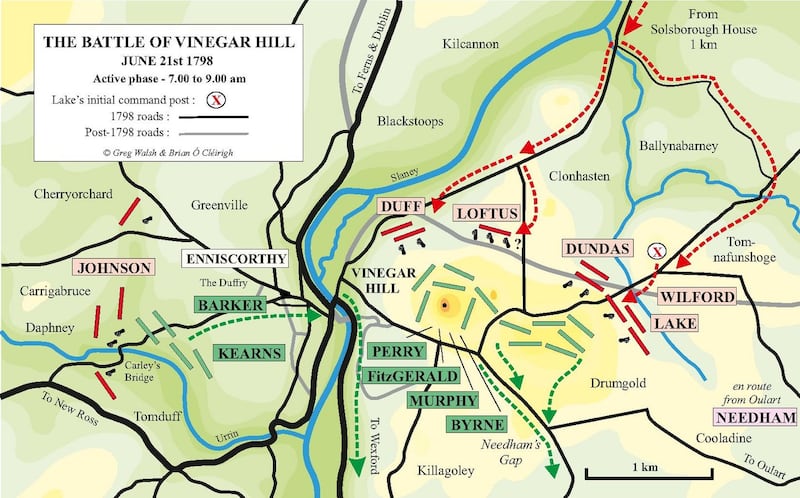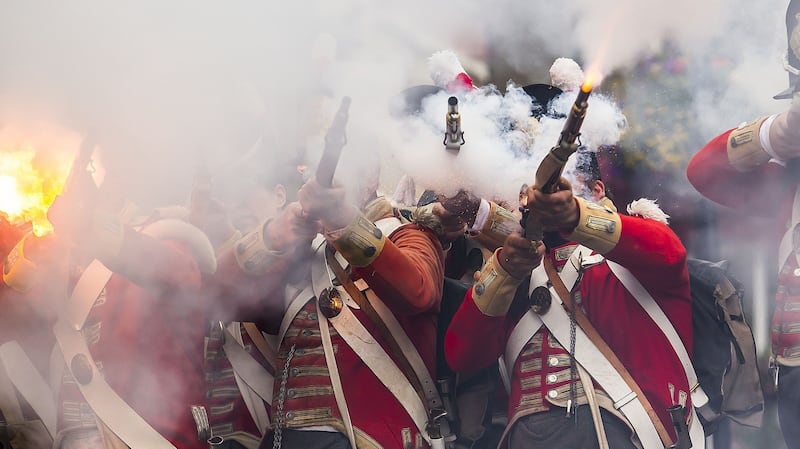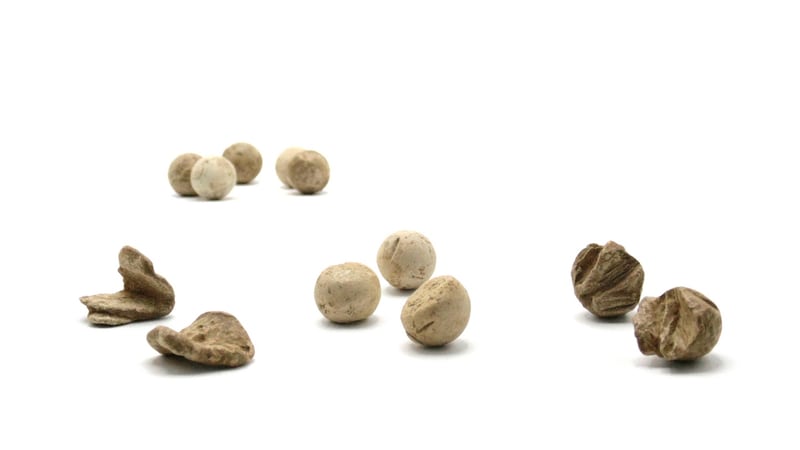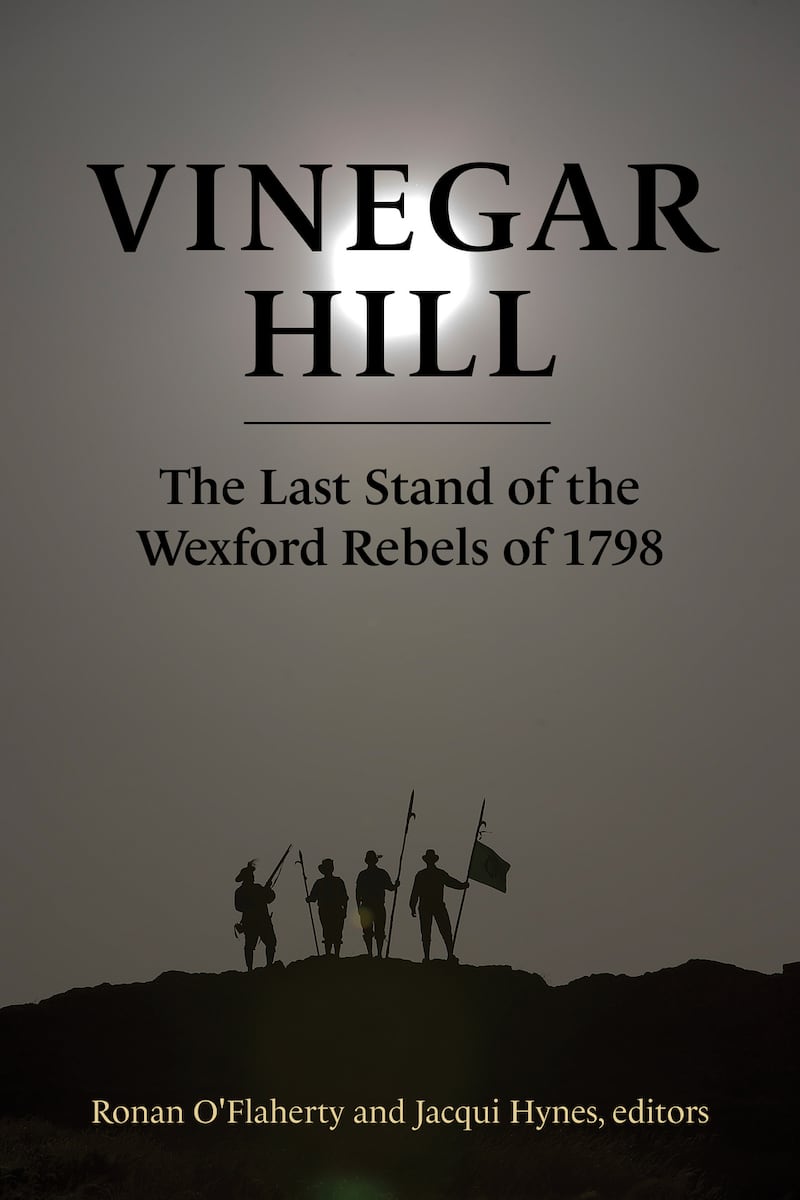It is June 21st, 1798. The longest day of a long hot summer. On a hill in Wexford are 20,000 men, women and children. They face a Crown force of some 15,000 troops led by no fewer than four generals and 16 general officers.
The hill in question is the evocatively-named Vinegar Hill, scene of the cataclysmic battle of the United Irishmen rebellion of 1798. The rebellion was supposed to erupt simultaneously across Ireland and, as the contemporary “prophecy” quoted in the title predicted, to overthrow the monarchy and establish a free, independent Irish republic. The reality was very different: betrayed by informers, the leaders were captured and the patchy uprising that followed was stamped out quickly.
Except in Wexford. The rebellion there saw almost the entire county fall into rebel hands, a Republic established and a surprisingly effective rebel army take the field. However, as the rising was brutally suppressed everywhere else, the Wexford rebels found themselves and their infant Republic increasingly isolated. It all came to an end on Vinegar Hill on that fateful day when the greatest military force seen in Ireland for a century slowly and methodically began to advance upon the remnants of the United Army and the people they protected.

The outcome is well-known. Another glorious defeat, destined to be remembered forever in song and story. However, surprisingly little is – or rather was – known about the course of the battle itself. It was to fill those gaps in our knowledge that the Longest Day Research Project was established. Supported by Wexford County Council, the Project brought together specialists from the fields of archaeology, history, folklore, military history and architectural history in a unique interdisciplinary approach never before applied to an Irish battlefield, and rarely to any battlefield internationally.
So, what really happened at Vinegar Hill?
Well, the first thing to ask is why it happened at all. Why did the rebels simply sit there and let themselves be surrounded? We know from accounts on the rebel side that there was significant disagreement on this point. Some of the rebel leaders felt that the United Army should disperse, become a guerrilla force, adopt the tactics which would prove so successful for the flying columns of the War of Independence a century later. Others were dismayed that nothing had been done to prepare the hill for battle, to clear ditches and embankments to allow the pikemen manoeuvre. But the advance of Government troops through Wexford had driven the civilian population before it and thousands had now gathered on Vinegar Hill. If the United Army withdrew, these people would have been defenceless. So they stayed.
The opposing Government force was enormous, perhaps as many as 15,000 troops, commanded by General Gerard Lake. His force included both cavalry and infantry, with some 26 artillery pieces and a baggage train almost 7km long. By contrast, the rebel camp included large numbers of non-combatants who had taken refuge on the hill. Those defending them and the hill were armed mainly with pikes and had only two rounds for their cannon. The line of command on the rebel side is unclear but the leaders included Anthony Perry, Miles Byrne and the charismatic Fr John Murphy of Boolavogue.
Lake was taking no chances. He gave the signal to advance at 4am, by which time General Johnson seems to have been already engaging the rebels to the west of Enniscorthy town just below Vinegar Hill. When all contingents had moved or were en route to their assigned positions, artillery bombardment of the hill began, about 7am. Lake had at his disposal a new exploding shell, used at Vinegar Hill for the first time. These were anti-personnel weapons, designed to explode above the enemy or seconds after landing. This was shock-and-awe warfare of a kind never seen before. Bombardment of the hill was combined with an infantry assault, and the attack continued for a full two hours. Contemporary accounts talk of the rebel defenders being slaughtered where they stood in their trenches.


Meanwhile in Enniscorthy, General Johnson had pushed the defenders back into the Market Square where desperate house-to-house fighting continued throughout the morning. The rebels gradually yielded ground until they reached the bridge across the Slaney. Here they made a last stand. Despite overwhelming odds, they held the bridge – this was to prove crucial later.
On the hill, the multi-pronged government attack was yielding results: Lieutenant General Dundas had made ground on the right flank, while Major Generals Loftus and Duff were pressing heavily on the centre and left. The rebel command began to contemplate a general retreat and had noticed a gap in the encircling forces to the south – a gap that was supposed to have been closed by the British commander Major General Needham.
A change to his orders meant that he was delayed in taking up his position, leaving a gap in the attack through which the rebels began to flood, sometime after 9am. Making the most of the opportunity, the United Army began an extraordinary and very successful fighting retreat. Protected to the west by their comrades holding the bridge across the Slaney and by an extremely effective rearguard action led by Fr Thomas Clinch, virtually the entire force made it off the hill intact. Once the main body of rebels had made good their escape, the defenders at the bridge made a successful retreat themselves. However, the rear-guard led by Fr Clinch was over-run and Clinch himself killed.
All might still have been lost, for as the rebel force flooded back towards Wexford Town, Major General Needham finally entered the field and began a pursuit which could have inflicted terrible casualties. However, just at that moment, a long-awaited relief force from Wexford under the rebel commander Edward Roche appeared.
The ferocity of Roche’s attack pushed General Needham back and under that cover the tattered remains of the rebel army limped into the temporary safety of Wexford Town, some 25km south. On the hill, however, the slaughter was only beginning: it is estimated that some 1,500 people were killed and hurriedly buried in mass graves. A visitor to the hill afterwards spoke of finding “numerous pits, crammed with dead bodies [which] seemed on some spots almost elastic as we stood on them”.
The new evidence
The work undertaken by the Longest Day Research Project has allowed the sequence of the battle, as summarised above, to be finally set down. It has established the full field of battle and the disposition of both Crown and rebel forces for the very first time. It has identified a shortlist of candidates for the all-important “Green Hill” – whose early capture by Crown forces sealed the fate of United Army.
It has located the site of the notorious rebel prison, Beale’s Barn, where loyalist prisoners were kept before being brought for trial and execution on Vinegar Hill. To the surprise of all, the dreadful prison still stands, incorporated into a courtyard of farm buildings just below the hill. Practical experiments undertaken with the assistance of the Reserve Defence Forces has shown that the Crown commander General Needham could never have reached his assigned position in time and that contemporary suggestions that he deliberately delayed to prevent a massacre are unfounded.
Careful analysis of contemporary accounts shows that a Republic was indeed established in Wexford – Ireland’s first republic – and that its memory was deliberately suppressed by surviving rebel leaders anxious to save their necks. The role played by women in the rebellion is revealed in the folklore and personal diaries. Underwater survey of the Slaney has identified likely locations for material surviving from the battle.
Metal detection of fields just below the summit of Vinegar Hill has produced such density of finds that key moments in the battle can now be reconstructed, including the last advance towards the summit where a firing-line of Redcoats can be detected, firing so rapidly that musket balls slipping from their hands were left ungathered from the surface. Perhaps most poignantly of all, the geophysical survey has identified for the first time what appears to be a number of mass graves on the hill, one big enough to hold hundreds of bodies.
Vinegar Hill is a remarkable site. Unlike many historic battlefields it has remained substantially intact: the attack-routes up the hill can still be traced, the ditches once lined by thousands of pikemen still stand, the graves of the dead are still there. As legend is replaced by hard fact, its story is in no way diminished. Rather it is enhanced as the drama and pathos of that last great stand comes into focus once more after 200 years.
Vinegar Hill: The Last Stand of the Wexford Rebels of 1798 is published by Four Courts Press, and is available now from all good local bookshops and online via fourcourtspress.ie for €25.











